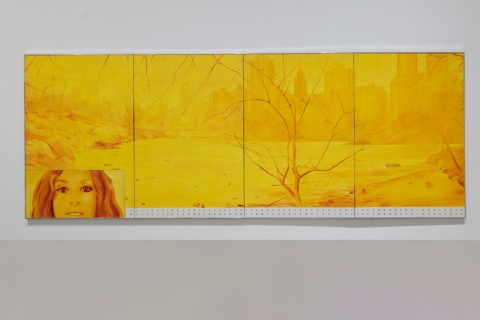<Potager - Garten (Der Kultivierte Küchengarten)>
In the mid-1970s, the painter Otto Schauer stayed in the Perche, a French region dotted with manor houses and hedged farmland, several times. The windows of the studio made available to him overlooked a vegetable garden in the throes of being replanted. In 1979-1980, it inspired around twenty paintings, of which this is the largest. Reconciling the order and chaos specific to this garden, bright yellow saturates the space and, through its chromatic intensity, encapsulates the explosive energy of nature in spring.

Centre Pompidou, Paris
Musée national d’art moderne - Centre de création industrielle
AM 1984-107
<A Small Garden>
This lush composition, with its acid colours, is inspired by the spectacle of nature. The American painter Joan Mitchell applied broad strokes of colour with energetic and rapid gestures that involved the whole body. The cobalt blue, dense at either end, narrows in the middle to reveal a large lemon-yellow aperture. The memory of Claude Monet at Giverny seems to emerge in this painting, which reproduces the impressions of a nearby garden. In 1968, Mitchell moved to Vétheuil, a town a few kilometres away from Giverny.

Centre Pompidou, Paris
Musée national d’art moderne - Centre de création industrielle
AM 1995-171
<Fayence>
In 1966, the Japanese painter Chūta Kimura, attracted by the memory of Pierre Bonnard’s work, settled in the Côte d’Azur. While Kimura roamed around this region of southern France, he quickly sketched landscapes in pencil. In this painting, he expresses a very personal vision of the landscape. On the left side of the canvas are the walls of La Roquette-sur-Siagne, where Kimura lived. On the right, a painterly struggle blurs perspective – shades of green, ochre and violet clash and swirl, enlivened by a black ring that indicates the essentials: a grove here, a house there. At the top, a single blue band is enough to suggest the radiant light of the Midi.

Centre Pompidou, Paris
Musée national d’art moderne - Centre de création industrielle
AM 2022-730
<New York n° 10>
In 1971, after a stay in New York, Jacques Monory created a series of twelve paintings inspired by the American metropolis. The panoramic format of New York No° 10, which extends over four panels, is reminiscent of the sequence of a film reel. This monochrome view of Central Park in winter is juxtaposed with a portrait of a woman. The words “Siberia”, “beauty”, “abyss”, “wounded”, “never”, “separated”, “Saharah [sic]”, “me”... appear at the bottom of the canvas. Whether intended as captions or subtitles, this evocation of uninhabited landscapes reinforces the intriguing nature of the images and the romantic scope of urban solitude.

Attribution, 1976
Centre Pompidou, Paris
Musée national d’art moderne - Centre de création industrielle
AM 1976-999
<Les Écrans du soleil>
The seaside is a recurring theme in the work of the Italian painter Leonardo Cremonini. In his paintings, flesh, rendered with a very thin layer of paint and acid colours, seems to liquefy in the sweltering summer heat. As a distant heir to Italian metaphysical painting, the artist lends an existential dimension to the inertia of the vacationers. In the centre of the lower part of this rigorously constructed image, a child holds a pair of glasses as if to offer them to the spectators, while all the adults have their eyes closed. The presence of this childlike figure lends this dazzling composition a melancholy quality.

Centre Pompidou, Paris
Musée national d’art moderne - Centre de création industrielle
AM 2024-675
<Paysage à Cagnes (La Gaude)>
The Belarusian painter Chaïm Soutine brought back around two hundred landscapes from his stays in the south of France, first in Céret and then in Cagnes in the years 1918-1919. They are characterised by the distortion of pictorial space and the expressionist violence of gestures and colours. In Cagnes, Soutine painted the hill of La Gaude several times. In this version, the curvilinear forms emphasise the instability of the composition, while the volumes seem in danger of being swallowed up by the thick paint.

Centre Pompidou, Paris
Musée national d’art moderne - Centre de création industrielle
AM 1997-28
<Paysage de l’Estaque>
Starting in 1906, Georges Braque undertook a series of trips to the south of France. Painted at the height of Fauvism, this landscape depicts a path overlooking the sea in the hills of L’Estaque, near Marseille. The elements of the composition are interwoven in a web of colourful arabesques, as if painted in a single stroke. Supported by sinuous blue shadows, the purple tree trunks seem to be dancing freely. The strong sunlight floods the different planes and allows them to merge. The white of the canvas, unpainted in places, contributes to this dazzling effect.

Centre Pompidou, Paris
Musée national d’art moderne - Centre de création industrielle
AM 1986-392